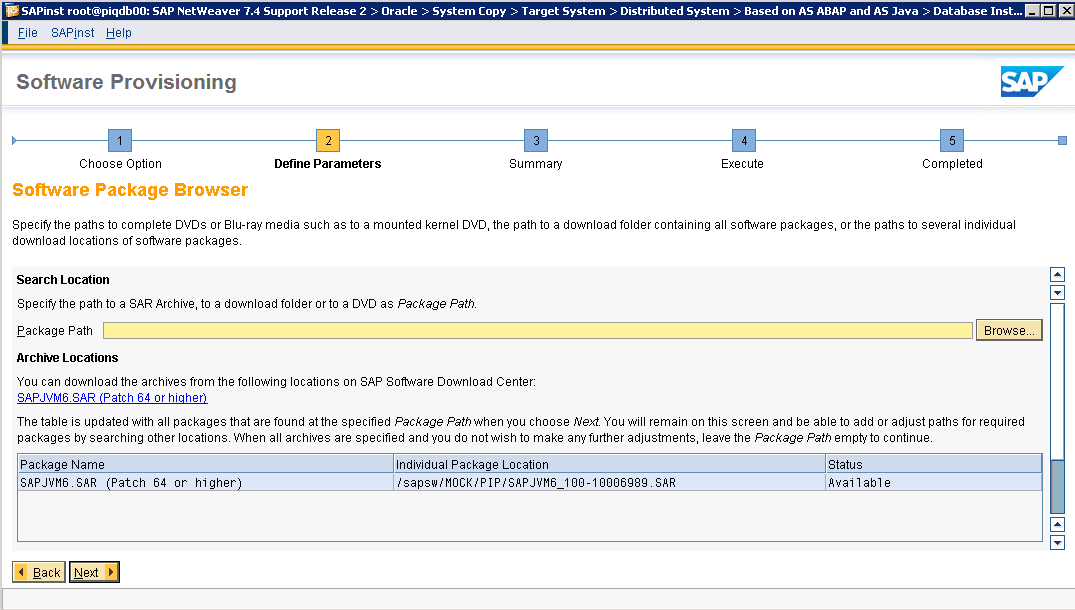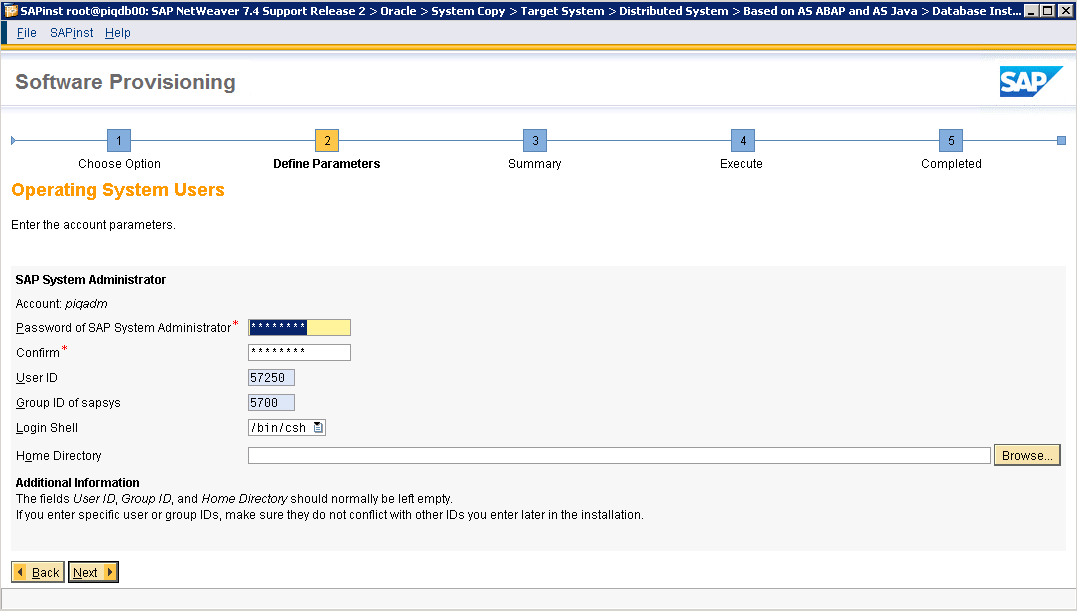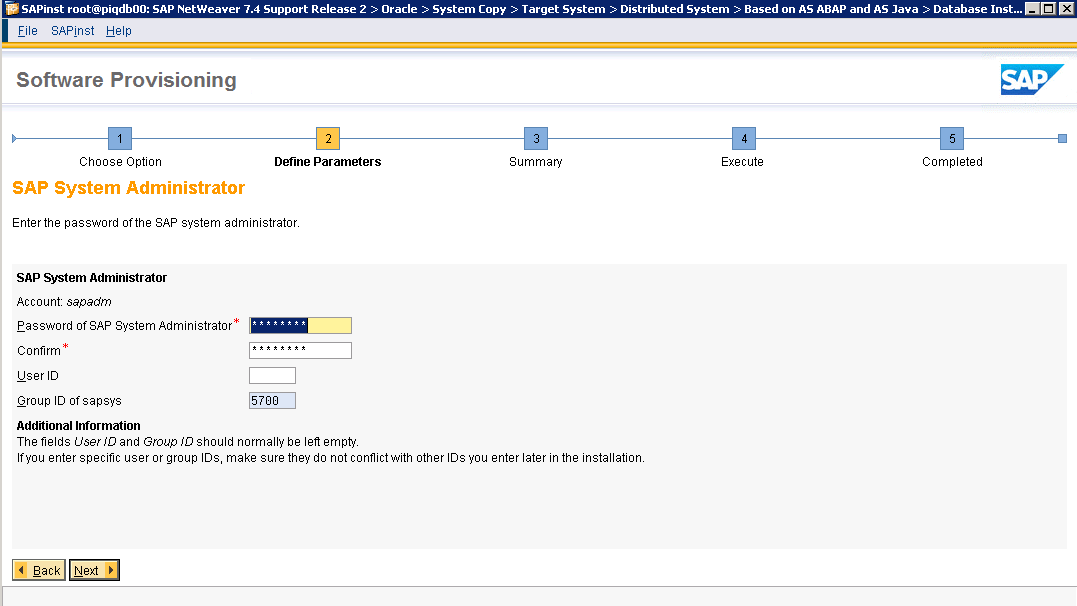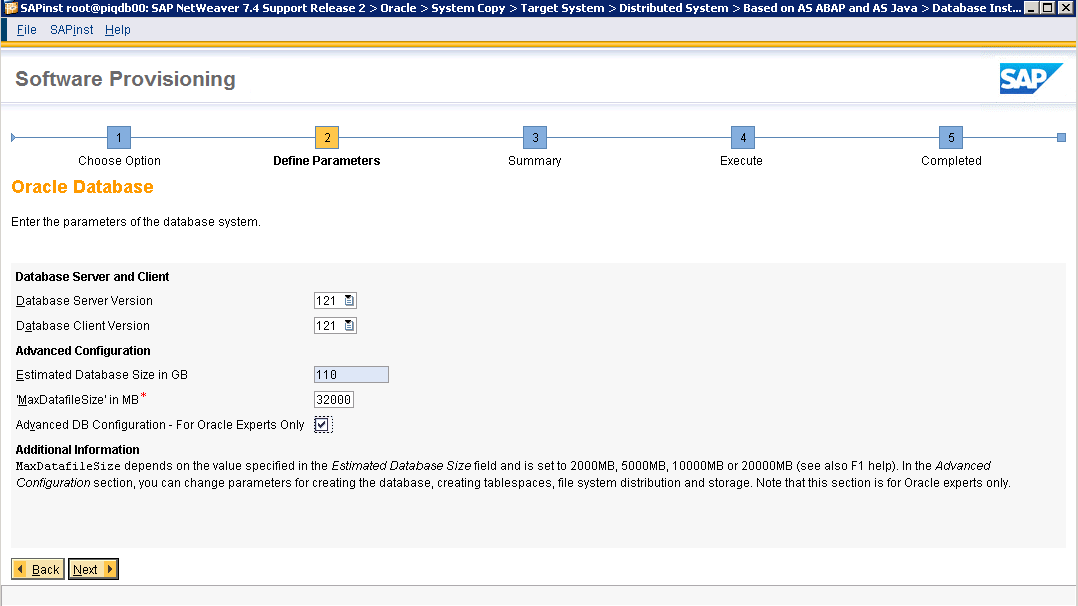
- SAP Community
- Products and Technology
- Technology
- Technology Blogs by Members
- SAP OS Upgrade from AIX to Linux – Part4
Technology Blogs by Members
Explore a vibrant mix of technical expertise, industry insights, and tech buzz in member blogs covering SAP products, technology, and events. Get in the mix!
Turn on suggestions
Auto-suggest helps you quickly narrow down your search results by suggesting possible matches as you type.
Showing results for
former_member60
Participant
Options
- Subscribe to RSS Feed
- Mark as New
- Mark as Read
- Bookmark
- Subscribe
- Printer Friendly Page
- Report Inappropriate Content
11-01-2019
6:48 PM
In the previous part1, part2 and part3 we have seen on how to export the DB from AIX and to install ASCS and SCS on Linux. In this part we will see on how to import the DB which we exported previously onto Linux.
Assumptions:
1. Successfully exported DB from AIX.
2. /sapmnt directory is mounted on piqdb00.
3. ASCS & SCS Instance is successfully installed.
1. Login into piqdb00 with root and goto root directory. Once we are in root create four directories like shown below. Once we create these directories we will add the mounts from ASCS in /etc/fstab. Given below are the screenshots.
[root@piqdb00 ~]# pwd
/
[root@piqdb00 /]# mkdir -p /sapmnt/PIQ/exe /sapmnt/PIQ/global /sapmnt/PIQ/profile /SWPM
[root@piqdb00 /]# vi /etc/fstab
##Mount points from ASCS
piqascs00:/sapmnt/PIQ/exe /sapmnt/PIQ/exe nfs defaults 0 0
piqascs00:/sapmnt/PIQ/profile /sapmnt/PIQ/profile nfs defaults 0 0
piqascs00:/sapmnt/PIQ/global /sapmnt/PIQ/global nfs defaults 0 0
piqascs00:/SWPM /SWPM nfs defaults 0 0
2. Once we added, mount it using command mount -a and check they are successfully mounted using df -k.
[root@piqdb00 /]#mount -a
[root@piqdb00 /]# df -k
3. Run SWPM and login with root user and password and Accept the certificate.
[root@piqdb00 SWPM]# nohup /SWPM/sapinst -nogui &


4. Login with root user and password.

5. Select Database Instance from the below path.

6. Select Custom.

7. Specify the path for JVM.

8. Specify the mount for Profile directory.

9. Specify Master Password.

10. Specify sidadm password.

11. Specify the database copy method as "Standard System Copy / Migration (Load-Based)".

12. Specify Database SID and host.

13. Specify the Kernel, HostAgent, DBATools location.

14. Specify sapadm password.

15. Specify the location of AIX Migration Export.

16. Unselect Target system Will Replace Source System in the below screen.

17. Specify the path for Java Component.

18. Specify the number of Parallel Jobs.

19. Specify Database Server and Client Version.

20. Specify Oracle sidam user.

21. Specify Oracle sidadm password.

22. Specify ABAP and JAVA schema names.

23. Specify No for Install Multitenant Database.

24. Specify Oralce Listener parameters.

25. Specify standard database users password.

26. Specify location for Oracle Server Software.

27. Check Database parameters. Since in step 19 we selected Advanced DB configuration - For Oracle Experts only we have the below options to check and change.



Added one entry for Init.ora: db_files=2000

28. Specify the Migration Key.

29. Specify Secure Store Key Phrase.

30. Specify to run Database Statistics yes or no. In our case we have selected Yes.

31. Specify Oracle client software location.

32. Make sure the parameters specified so far are good else revise in the below screen and click Next.

33. Installation will start and will stop at the below screen for installing Oracle from OS level.

34. Install Oracle from OS (not covered in this series). If we want to know on how to do this please comment I have to do a different weblog.
35. Once Oracle is installed from OS level say OK in the above screen.
36. Given below are some screen shots while it is executing.

Note: First it imports ABAP and then JAVA. If all goes well then we are lucky 🙂 But thats not reality. If we get errors during import then logs are written to: /tmp/sapinst_instdir/NW740SR2/ORA/COPY/SYSTEM/DISTRIBUTED/AS/DB
At the end of ABAP import if we recieve any indexes as errors then we might ignore it by going into the corresponding .tsk file and change the err to ign. In my case I have an index error which is shown in the file: SAPAPPL1.TSK as P GVD_SGASTAT~0 C err
Change it to P GVD_SGASTAT~0 C ign --> save the file and rerun the process. Keep a note that way when the process is completed we have to regenerate the indexes.
37. Once ABAP imports successfully if we ignore anything then we recieve the warning like below and we say OK.

38. Once ABAP imports it moves to JAVA.

39. Once ABAP and JAVA imports successfully then we receive the successful message.

With this we have successfully imported the Database.
Now we have successfully exported AIX Oracle DB onto Linux lets move onto installing Primary Application Server and Second Application Server in Part5.
Assumptions:
1. Successfully exported DB from AIX.
2. /sapmnt directory is mounted on piqdb00.
3. ASCS & SCS Instance is successfully installed.
1. Login into piqdb00 with root and goto root directory. Once we are in root create four directories like shown below. Once we create these directories we will add the mounts from ASCS in /etc/fstab. Given below are the screenshots.
[root@piqdb00 ~]# pwd
/
[root@piqdb00 /]# mkdir -p /sapmnt/PIQ/exe /sapmnt/PIQ/global /sapmnt/PIQ/profile /SWPM
[root@piqdb00 /]# vi /etc/fstab
##Mount points from ASCS
piqascs00:/sapmnt/PIQ/exe /sapmnt/PIQ/exe nfs defaults 0 0
piqascs00:/sapmnt/PIQ/profile /sapmnt/PIQ/profile nfs defaults 0 0
piqascs00:/sapmnt/PIQ/global /sapmnt/PIQ/global nfs defaults 0 0
piqascs00:/SWPM /SWPM nfs defaults 0 0
2. Once we added, mount it using command mount -a and check they are successfully mounted using df -k.
[root@piqdb00 /]#mount -a
[root@piqdb00 /]# df -k
3. Run SWPM and login with root user and password and Accept the certificate.
[root@piqdb00 SWPM]# nohup /SWPM/sapinst -nogui &


4. Login with root user and password.

5. Select Database Instance from the below path.

6. Select Custom.

7. Specify the path for JVM.

8. Specify the mount for Profile directory.

9. Specify Master Password.

10. Specify sidadm password.

11. Specify the database copy method as "Standard System Copy / Migration (Load-Based)".

12. Specify Database SID and host.

13. Specify the Kernel, HostAgent, DBATools location.

14. Specify sapadm password.

15. Specify the location of AIX Migration Export.

16. Unselect Target system Will Replace Source System in the below screen.

17. Specify the path for Java Component.

18. Specify the number of Parallel Jobs.

19. Specify Database Server and Client Version.

20. Specify Oracle sidam user.

21. Specify Oracle sidadm password.

22. Specify ABAP and JAVA schema names.

23. Specify No for Install Multitenant Database.

24. Specify Oralce Listener parameters.

25. Specify standard database users password.

26. Specify location for Oracle Server Software.

27. Check Database parameters. Since in step 19 we selected Advanced DB configuration - For Oracle Experts only we have the below options to check and change.



Added one entry for Init.ora: db_files=2000

28. Specify the Migration Key.

29. Specify Secure Store Key Phrase.

30. Specify to run Database Statistics yes or no. In our case we have selected Yes.

31. Specify Oracle client software location.

32. Make sure the parameters specified so far are good else revise in the below screen and click Next.

33. Installation will start and will stop at the below screen for installing Oracle from OS level.

34. Install Oracle from OS (not covered in this series). If we want to know on how to do this please comment I have to do a different weblog.
35. Once Oracle is installed from OS level say OK in the above screen.
36. Given below are some screen shots while it is executing.

Note: First it imports ABAP and then JAVA. If all goes well then we are lucky 🙂 But thats not reality. If we get errors during import then logs are written to: /tmp/sapinst_instdir/NW740SR2/ORA/COPY/SYSTEM/DISTRIBUTED/AS/DB
At the end of ABAP import if we recieve any indexes as errors then we might ignore it by going into the corresponding .tsk file and change the err to ign. In my case I have an index error which is shown in the file: SAPAPPL1.TSK as P GVD_SGASTAT~0 C err
Change it to P GVD_SGASTAT~0 C ign --> save the file and rerun the process. Keep a note that way when the process is completed we have to regenerate the indexes.
37. Once ABAP imports successfully if we ignore anything then we recieve the warning like below and we say OK.

38. Once ABAP imports it moves to JAVA.

39. Once ABAP and JAVA imports successfully then we receive the successful message.

With this we have successfully imported the Database.
Now we have successfully exported AIX Oracle DB onto Linux lets move onto installing Primary Application Server and Second Application Server in Part5.
1 Comment
You must be a registered user to add a comment. If you've already registered, sign in. Otherwise, register and sign in.
Labels in this area
-
"automatische backups"
1 -
"regelmäßige sicherung"
1 -
"TypeScript" "Development" "FeedBack"
1 -
505 Technology Updates 53
1 -
ABAP
14 -
ABAP API
1 -
ABAP CDS Views
2 -
ABAP CDS Views - BW Extraction
1 -
ABAP CDS Views - CDC (Change Data Capture)
1 -
ABAP class
2 -
ABAP Cloud
2 -
ABAP Development
5 -
ABAP in Eclipse
1 -
ABAP Platform Trial
1 -
ABAP Programming
2 -
abap technical
1 -
absl
1 -
access data from SAP Datasphere directly from Snowflake
1 -
Access data from SAP datasphere to Qliksense
1 -
Accrual
1 -
action
1 -
adapter modules
1 -
Addon
1 -
Adobe Document Services
1 -
ADS
1 -
ADS Config
1 -
ADS with ABAP
1 -
ADS with Java
1 -
ADT
2 -
Advance Shipping and Receiving
1 -
Advanced Event Mesh
3 -
AEM
1 -
AI
7 -
AI Launchpad
1 -
AI Projects
1 -
AIML
9 -
Alert in Sap analytical cloud
1 -
Amazon S3
1 -
Analytical Dataset
1 -
Analytical Model
1 -
Analytics
1 -
Analyze Workload Data
1 -
annotations
1 -
API
1 -
API and Integration
3 -
API Call
2 -
Application Architecture
1 -
Application Development
5 -
Application Development for SAP HANA Cloud
3 -
Applications and Business Processes (AP)
1 -
Artificial Intelligence
1 -
Artificial Intelligence (AI)
4 -
Artificial Intelligence (AI) 1 Business Trends 363 Business Trends 8 Digital Transformation with Cloud ERP (DT) 1 Event Information 462 Event Information 15 Expert Insights 114 Expert Insights 76 Life at SAP 418 Life at SAP 1 Product Updates 4
1 -
Artificial Intelligence (AI) blockchain Data & Analytics
1 -
Artificial Intelligence (AI) blockchain Data & Analytics Intelligent Enterprise
1 -
Artificial Intelligence (AI) blockchain Data & Analytics Intelligent Enterprise Oil Gas IoT Exploration Production
1 -
Artificial Intelligence (AI) blockchain Data & Analytics Intelligent Enterprise sustainability responsibility esg social compliance cybersecurity risk
1 -
ASE
1 -
ASR
2 -
ASUG
1 -
Attachments
1 -
Authorisations
1 -
Automating Processes
1 -
Automation
1 -
aws
2 -
Azure
1 -
Azure AI Studio
1 -
B2B Integration
1 -
Backorder Processing
1 -
Backup
1 -
Backup and Recovery
1 -
Backup schedule
1 -
BADI_MATERIAL_CHECK error message
1 -
Bank
1 -
BAS
1 -
basis
2 -
Basis Monitoring & Tcodes with Key notes
2 -
Batch Management
1 -
BDC
1 -
Best Practice
1 -
bitcoin
1 -
Blockchain
3 -
BOP in aATP
1 -
BOP Segments
1 -
BOP Strategies
1 -
BOP Variant
1 -
BPC
1 -
BPC LIVE
1 -
BTP
11 -
BTP Destination
2 -
Business AI
1 -
Business and IT Integration
1 -
Business application stu
1 -
Business Application Studio
1 -
Business Architecture
1 -
Business Communication Services
1 -
Business Continuity
1 -
Business Data Fabric
3 -
Business Partner
12 -
Business Partner Master Data
10 -
Business Technology Platform
2 -
Business Trends
1 -
CA
1 -
calculation view
1 -
CAP
3 -
Capgemini
1 -
CAPM
1 -
Catalyst for Efficiency: Revolutionizing SAP Integration Suite with Artificial Intelligence (AI) and
1 -
CCMS
2 -
CDQ
12 -
CDS
2 -
Cental Finance
1 -
Certificates
1 -
CFL
1 -
Change Management
1 -
chatbot
1 -
chatgpt
3 -
CL_SALV_TABLE
2 -
Class Runner
1 -
Classrunner
1 -
Cloud ALM Monitoring
1 -
Cloud ALM Operations
1 -
cloud connector
1 -
Cloud Extensibility
1 -
Cloud Foundry
4 -
Cloud Integration
6 -
Cloud Platform Integration
2 -
cloudalm
1 -
communication
1 -
Compensation Information Management
1 -
Compensation Management
1 -
Compliance
1 -
Compound Employee API
1 -
Configuration
1 -
Connectors
1 -
Consolidation Extension for SAP Analytics Cloud
1 -
Controller-Service-Repository pattern
1 -
Conversion
1 -
Cosine similarity
1 -
cryptocurrency
1 -
CSI
1 -
ctms
1 -
Custom chatbot
3 -
Custom Destination Service
1 -
custom fields
1 -
Customer Experience
1 -
Customer Journey
1 -
Customizing
1 -
cyber security
2 -
Data
1 -
Data & Analytics
1 -
Data Aging
1 -
Data Analytics
2 -
Data and Analytics (DA)
1 -
Data Archiving
1 -
Data Back-up
1 -
Data Governance
5 -
Data Integration
2 -
Data Quality
12 -
Data Quality Management
12 -
Data Synchronization
1 -
data transfer
1 -
Data Unleashed
1 -
Data Value
8 -
database tables
1 -
Datasphere
2 -
datenbanksicherung
1 -
dba cockpit
1 -
dbacockpit
1 -
Debugging
2 -
Delimiting Pay Components
1 -
Delta Integrations
1 -
Destination
3 -
Destination Service
1 -
Developer extensibility
1 -
Developing with SAP Integration Suite
1 -
Devops
1 -
digital transformation
1 -
Documentation
1 -
Dot Product
1 -
DQM
1 -
dump database
1 -
dump transaction
1 -
e-Invoice
1 -
E4H Conversion
1 -
Eclipse ADT ABAP Development Tools
2 -
edoc
1 -
edocument
1 -
ELA
1 -
Embedded Consolidation
1 -
Embedding
1 -
Embeddings
1 -
Employee Central
1 -
Employee Central Payroll
1 -
Employee Central Time Off
1 -
Employee Information
1 -
Employee Rehires
1 -
Enable Now
1 -
Enable now manager
1 -
endpoint
1 -
Enhancement Request
1 -
Enterprise Architecture
1 -
ETL Business Analytics with SAP Signavio
1 -
Euclidean distance
1 -
Event Dates
1 -
Event Driven Architecture
1 -
Event Mesh
2 -
Event Reason
1 -
EventBasedIntegration
1 -
EWM
1 -
EWM Outbound configuration
1 -
EWM-TM-Integration
1 -
Existing Event Changes
1 -
Expand
1 -
Expert
2 -
Expert Insights
1 -
Fiori
14 -
Fiori Elements
2 -
Fiori SAPUI5
12 -
Flask
1 -
Full Stack
8 -
Funds Management
1 -
General
1 -
Generative AI
1 -
Getting Started
1 -
GitHub
8 -
Grants Management
1 -
groovy
1 -
GTP
1 -
HANA
5 -
HANA Cloud
2 -
Hana Cloud Database Integration
2 -
HANA DB
1 -
HANA XS Advanced
1 -
Historical Events
1 -
home labs
1 -
HowTo
1 -
HR Data Management
1 -
html5
8 -
HTML5 Application
1 -
Identity cards validation
1 -
idm
1 -
Implementation
1 -
input parameter
1 -
instant payments
1 -
Integration
3 -
Integration Advisor
1 -
Integration Architecture
1 -
Integration Center
1 -
Integration Suite
1 -
intelligent enterprise
1 -
Java
1 -
job
1 -
Job Information Changes
1 -
Job-Related Events
1 -
Job_Event_Information
1 -
joule
4 -
Journal Entries
1 -
Just Ask
1 -
Kerberos for ABAP
8 -
Kerberos for JAVA
8 -
Launch Wizard
1 -
Learning Content
2 -
Life at SAP
1 -
lightning
1 -
Linear Regression SAP HANA Cloud
1 -
local tax regulations
1 -
LP
1 -
Machine Learning
2 -
Marketing
1 -
Master Data
3 -
Master Data Management
14 -
Maxdb
2 -
MDG
1 -
MDGM
1 -
MDM
1 -
Message box.
1 -
Messages on RF Device
1 -
Microservices Architecture
1 -
Microsoft Universal Print
1 -
Middleware Solutions
1 -
Migration
5 -
ML Model Development
1 -
Modeling in SAP HANA Cloud
8 -
Monitoring
3 -
MTA
1 -
Multi-Record Scenarios
1 -
Multiple Event Triggers
1 -
Neo
1 -
New Event Creation
1 -
New Feature
1 -
Newcomer
1 -
NodeJS
2 -
ODATA
2 -
OData APIs
1 -
odatav2
1 -
ODATAV4
1 -
ODBC
1 -
ODBC Connection
1 -
Onpremise
1 -
open source
2 -
OpenAI API
1 -
Oracle
1 -
PaPM
1 -
PaPM Dynamic Data Copy through Writer function
1 -
PaPM Remote Call
1 -
PAS-C01
1 -
Pay Component Management
1 -
PGP
1 -
Pickle
1 -
PLANNING ARCHITECTURE
1 -
Popup in Sap analytical cloud
1 -
PostgrSQL
1 -
POSTMAN
1 -
Process Automation
2 -
Product Updates
4 -
PSM
1 -
Public Cloud
1 -
Python
4 -
Qlik
1 -
Qualtrics
1 -
RAP
3 -
RAP BO
2 -
Record Deletion
1 -
Recovery
1 -
recurring payments
1 -
redeply
1 -
Release
1 -
Remote Consumption Model
1 -
Replication Flows
1 -
Research
1 -
Resilience
1 -
REST
1 -
REST API
1 -
Retagging Required
1 -
Risk
1 -
Rolling Kernel Switch
1 -
route
1 -
rules
1 -
S4 HANA
1 -
S4 HANA Cloud
1 -
S4 HANA On-Premise
1 -
S4HANA
3 -
S4HANA_OP_2023
2 -
SAC
10 -
SAC PLANNING
9 -
SAP
4 -
SAP ABAP
1 -
SAP Advanced Event Mesh
1 -
SAP AI Core
8 -
SAP AI Launchpad
8 -
SAP Analytic Cloud Compass
1 -
Sap Analytical Cloud
1 -
SAP Analytics Cloud
4 -
SAP Analytics Cloud for Consolidation
2 -
SAP Analytics Cloud Story
1 -
SAP analytics clouds
1 -
SAP BAS
1 -
SAP Basis
6 -
SAP BODS
1 -
SAP BODS certification.
1 -
SAP BTP
20 -
SAP BTP Build Work Zone
2 -
SAP BTP Cloud Foundry
5 -
SAP BTP Costing
1 -
SAP BTP CTMS
1 -
SAP BTP Innovation
1 -
SAP BTP Migration Tool
1 -
SAP BTP SDK IOS
1 -
SAP Build
11 -
SAP Build App
1 -
SAP Build apps
1 -
SAP Build CodeJam
1 -
SAP Build Process Automation
3 -
SAP Build work zone
10 -
SAP Business Objects Platform
1 -
SAP Business Technology
2 -
SAP Business Technology Platform (XP)
1 -
sap bw
1 -
SAP CAP
2 -
SAP CDC
1 -
SAP CDP
1 -
SAP CDS VIEW
1 -
SAP Certification
1 -
SAP Cloud ALM
4 -
SAP Cloud Application Programming Model
1 -
SAP Cloud Integration for Data Services
1 -
SAP cloud platform
8 -
SAP Companion
1 -
SAP CPI
3 -
SAP CPI (Cloud Platform Integration)
2 -
SAP CPI Discover tab
1 -
sap credential store
1 -
SAP Customer Data Cloud
1 -
SAP Customer Data Platform
1 -
SAP Data Intelligence
1 -
SAP Data Migration in Retail Industry
1 -
SAP Data Services
1 -
SAP DATABASE
1 -
SAP Dataspher to Non SAP BI tools
1 -
SAP Datasphere
9 -
SAP DRC
1 -
SAP EWM
1 -
SAP Fiori
2 -
SAP Fiori App Embedding
1 -
Sap Fiori Extension Project Using BAS
1 -
SAP GRC
1 -
SAP HANA
1 -
SAP HCM (Human Capital Management)
1 -
SAP HR Solutions
1 -
SAP IDM
1 -
SAP Integration Suite
9 -
SAP Integrations
4 -
SAP iRPA
2 -
SAP Learning Class
1 -
SAP Learning Hub
1 -
SAP Odata
2 -
SAP on Azure
1 -
SAP PartnerEdge
1 -
sap partners
1 -
SAP Password Reset
1 -
SAP PO Migration
1 -
SAP Prepackaged Content
1 -
SAP Process Automation
2 -
SAP Process Integration
2 -
SAP Process Orchestration
1 -
SAP S4HANA
2 -
SAP S4HANA Cloud
1 -
SAP S4HANA Cloud for Finance
1 -
SAP S4HANA Cloud private edition
1 -
SAP Sandbox
1 -
SAP STMS
1 -
SAP SuccessFactors
2 -
SAP SuccessFactors HXM Core
1 -
SAP Time
1 -
SAP TM
2 -
SAP Trading Partner Management
1 -
SAP UI5
1 -
SAP Upgrade
1 -
SAP Utilities
1 -
SAP-GUI
8 -
SAP_COM_0276
1 -
SAPBTP
1 -
SAPCPI
1 -
SAPEWM
1 -
sapmentors
1 -
saponaws
2 -
SAPS4HANA
1 -
SAPUI5
4 -
schedule
1 -
Secure Login Client Setup
8 -
security
9 -
Selenium Testing
1 -
SEN
1 -
SEN Manager
1 -
service
1 -
SET_CELL_TYPE
1 -
SET_CELL_TYPE_COLUMN
1 -
SFTP scenario
2 -
Simplex
1 -
Single Sign On
8 -
Singlesource
1 -
SKLearn
1 -
soap
1 -
Software Development
1 -
SOLMAN
1 -
solman 7.2
2 -
Solution Manager
3 -
sp_dumpdb
1 -
sp_dumptrans
1 -
SQL
1 -
sql script
1 -
SSL
8 -
SSO
8 -
Substring function
1 -
SuccessFactors
1 -
SuccessFactors Time Tracking
1 -
Sybase
1 -
system copy method
1 -
System owner
1 -
Table splitting
1 -
Tax Integration
1 -
Technical article
1 -
Technical articles
1 -
Technology Updates
1 -
Technology Updates
1 -
Technology_Updates
1 -
Threats
1 -
Time Collectors
1 -
Time Off
2 -
Tips and tricks
2 -
Tools
1 -
Trainings & Certifications
1 -
Transport in SAP BODS
1 -
Transport Management
1 -
TypeScript
2 -
unbind
1 -
Unified Customer Profile
1 -
UPB
1 -
Use of Parameters for Data Copy in PaPM
1 -
User Unlock
1 -
VA02
1 -
Validations
1 -
Vector Database
1 -
Vector Engine
1 -
Visual Studio Code
1 -
VSCode
1 -
Web SDK
1 -
work zone
1 -
workload
1 -
xsa
1 -
XSA Refresh
1
- « Previous
- Next »
Related Content
- Combine SKUs - Application Server 8018022 and 8018042 in Technology Q&A
- S/4HANA 2023 FPS00 Upgrade in Technology Blogs by Members
- Oracle linux/OS upgrade in Technology Q&A
- RHEL AND SAP UPGRADE WITH COMPATIBILITY CHECKS #ATR in Technology Blogs by Members
- TREX Revision Upgrade on Linux through shell script and Troubleshooting in Technology Blogs by Members
Top kudoed authors
| User | Count |
|---|---|
| 11 | |
| 10 | |
| 7 | |
| 6 | |
| 4 | |
| 4 | |
| 3 | |
| 3 | |
| 3 | |
| 3 |